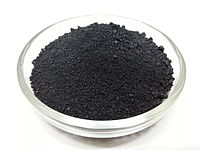Ruthenium trichloride
 |
|
 |
|
| Identifiers | |
|---|---|
|
|
|
3D model (Jmol)
|
|
| ChemSpider | |
| ECHA InfoCard | 100.030.139 |
|
PubChem CID
|
|
| RTECS number | VM2650000 |
| UNII | |
|
|
|
|
| Properties | |
| RuCl3·xH2O | |
| Molar mass | 207.43 g/mol |
| Melting point | > 500 °C (932 °F; 773 K) (decomposes) |
| Soluble | |
| +1998.0·10−6 cm3/mol | |
| Structure | |
| trigonal (RuCl3), hP8 | |
| P3c1, No. 158 | |
| octahedral | |
| Hazards | |
| Flash point | Non-flammable |
| Related compounds | |
|
Other anions
|
Ruthenium(III) bromide |
|
Other cations
|
Rhodium(III) chloride Iron(III) chloride |
|
Related compounds
|
Ruthenium tetroxide |
|
Except where otherwise noted, data are given for materials in their standard state (at 25 °C [77 °F], 100 kPa).
|
|
|
|
|
| Infobox references | |
Ruthenium(III) chloride is the chemical compound with the formula RuCl3. "Ruthenium(III) chloride" more commonly refers to the hydrate RuCl3·xH2O. Both the anhydrous and hydrated species are dark brown or black solids. The hydrate, with a varying proportion of water of crystallization, often approximating to a trihydrate, is a commonly used starting material in ruthenium chemistry.
Anhydrous ruthenium(III) chloride is usually prepared by heating powdered ruthenium metal with chlorine. In the original synthesis, the chlorination was conducted in the presence of carbon monoxide, the product being carried by the gas stream and crystallising upon cooling. Two allotropes of RuCl3 are known. The black α-form adopts the CrCl3-type structure with long Ru-Ru contacts of 346 pm. The dark brown metastable β-form crystallizes in a hexagonal cell; this form consists of infinite chains of face-sharing octahedra with Ru-Ru contacts of 283 pm, similar to the structure of zirconium trichloride. The β-form is irreversibly converted to the α-form at 450–600 °C. The β-form is diamagnetic, whereas α-RuCl3 is paramagnetic.
RuCl3 vapour decomposes into the elements at high temperatures ; the enthalpy change at 750 °C (1020 K), ΔdissH1020 has been estimated as +240 kJ/mol.
As the most commonly available ruthenium compound, RuCl3·xH2O is the precursor to many hundreds of chemical compounds. The noteworthy property of ruthenium complexes, chlorides and otherwise, is the existence of more than one oxidation state, several of which are kinetically inert. All second and third-row transition metals form exclusively low spin complexes, whereas ruthenium is special in the stability of adjacent oxidation states, especially Ru(II), Ru(III) (as in the parent RuCl3·xH2O) and Ru(IV).
The benzene ligand can be exchanged with other arenes such as hexamethylbenzene.
This reaction proceeds via the intermediate cis-Ru(bipy)2Cl2.
...
Wikipedia
